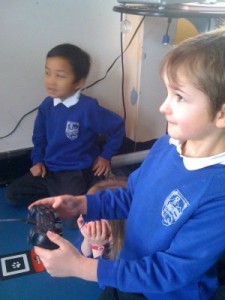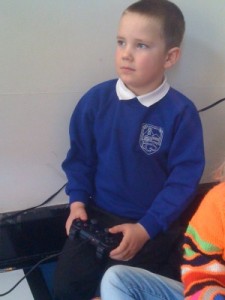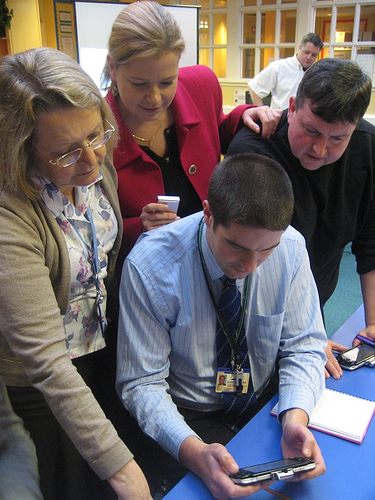

Consolarium blog
 The Eyepet for the Sony PS3 is a resource that the Consolarium team believe has great potential in schools. The promise of an augmented reality Nintendogs type character on the big screen that could be interacted with by groups of children was something that we felt would prove to be a magical experience for young learners. When we first hatched and played with our Eyepet at the Consolarium we experienced for ourselves the power of this technology and we immediately began discussing just what this could bring to teaching and learning. We were enchanted with this beautiful yet vulnerable little creature and after much hand waving in mid-air our Eyepet came to trust us and looking after it became part of our day.
The Eyepet for the Sony PS3 is a resource that the Consolarium team believe has great potential in schools. The promise of an augmented reality Nintendogs type character on the big screen that could be interacted with by groups of children was something that we felt would prove to be a magical experience for young learners. When we first hatched and played with our Eyepet at the Consolarium we experienced for ourselves the power of this technology and we immediately began discussing just what this could bring to teaching and learning. We were enchanted with this beautiful yet vulnerable little creature and after much hand waving in mid-air our Eyepet came to trust us and looking after it became part of our day.
We put Eyepets in a number of schools across Scotland to see how teachers might begin to integrate the resource into their teaching. Cathkin Community Nursery in South Lanarkshire made superb use of their Eyepet and its application in the learning experiences of their learners was commented on favourably by HMIE. We have also spoken with many other teachers who have had similarly positive experiences however we have also had some teachers who have felt that the resource is not for them or for their children because it is too difficult to use. There is a knack to controlling the Eyepet with the card that is supplied (feeding the Eyepet and throwing biscuits for it is really quite tricky when you first start) so maybe this is a training issue for the Consolarium team. The advent of the Move controller for the PS3 has made this aspect of using the Eyepet a lot easier though. This being said there are many teachers in schools that we are working with who are making great progress with the resource as it is.
On a recent visit to Islay I visited Port Charlotte PS where I was introduced to P2-3 teacher Catherine MacMillan. Catherine is one of the teachers in Argyll & Bute who is working with the Eyepet this term. I was introduced to her class, some of whom were working away in the corner about to hatch their first Eyepet. Here they are going through the initial stages of the hatching process:
After the Eyepet had hatched it had to be scanned to see if it was hungry or not. Here we see the children scanning their new Eyepet to see if it requires feeding or not. :
 Whenever I have seen the Eyepet used in schools I am always drawn to the look of concentration and involvement on the faces of the children as they play/learn with the resource. Can you see that on the children’s faces here? It also has to be said that the thoughtful and considered application of this engaging resource by teachers really can ‘make learning more creative, challenging and fun.’ This is most certainly the case with Catherine MacMillan because as we talked I quickly saw how she had seen the potential of this resource and just how it could help her deliver learning experiences in Curriculum for Excellence that would offer the challenge, demand and appeal that Port Charlotte PS expects. Her initial foray into making links to other curricular areas was focused on Writing. She saw the perfect opportunity to capitalise on the supportive discussions that were naturally occurring in the children’s groups when they were showing each other what to do with the Eyepet. This instruction giving would be explored further as part of a purposeful and relevant writing activity focusing on instruction writing. One could associate this activity with this Outcome from CfE:
Whenever I have seen the Eyepet used in schools I am always drawn to the look of concentration and involvement on the faces of the children as they play/learn with the resource. Can you see that on the children’s faces here? It also has to be said that the thoughtful and considered application of this engaging resource by teachers really can ‘make learning more creative, challenging and fun.’ This is most certainly the case with Catherine MacMillan because as we talked I quickly saw how she had seen the potential of this resource and just how it could help her deliver learning experiences in Curriculum for Excellence that would offer the challenge, demand and appeal that Port Charlotte PS expects. Her initial foray into making links to other curricular areas was focused on Writing. She saw the perfect opportunity to capitalise on the supportive discussions that were naturally occurring in the children’s groups when they were showing each other what to do with the Eyepet. This instruction giving would be explored further as part of a purposeful and relevant writing activity focusing on instruction writing. One could associate this activity with this Outcome from CfE:
“I am learning to use my notes and other types of writing to help me understand information and ideas, explore problems, generate and develop ideas or create new text.” LIT 1-25a
Have a look at some of the children’s writing:
Here is Catherine talking about how she planned for this activity and how the Eyepet is helping her deliver this aspect of her teaching.
As Catherine and I talked the children played away quite confidently and contentedly and took charge of looking after their new Eyepet. I took the opportunity to continue talking about just what technologies such as games can bring to the classroom. Catherine had clearly given some serious thought to the application and appeal of a resource such as the Eyepet and as we talked she focused on the following aspects as positive reasons to use the Eyepet and also what she had seen for herself in the short time that she had been using the resource:
As you can see from the video, the children still carried on working independently as we chatted. So much so that even when the bell rang it took some encouraging to get the children away from their Eyepet and out to play:
We also discussed how, amongst other things, Catherine and her colleagues are using the Eyepet to aid transition from the nursery class to Primary 1. You can hear our discussion (over the children using the hairdryer to dry their Eyepet) here:
Transcript of discussion with Catherine MacMillan
We will be sharing some more experiences of teachers in Scottish classrooms who are using the Eyepet over the coming months. No doubt we will see some more innovative yet grounded practice from many of the teachers currently using the resource. If you are using this resource in your own setting then please do get in touch and share with us what your experience has been.
At the Game To Learn: Take2! Conference in Dundee on Saturday 19 March Brian McLaren, DHT Clackmannan PS (ex Consolarium Development Officer) will be delivering a seminar in which he will talk about his experience of leading the Eyepet initiative for the Consolarium. Come along to hear what Brian has to say.
*Full transcription of videos to come
MoreThe Sony PSP project in the P.7 class in Campie P.S. in Musselburgh is well under way. The children have all been given their PSPs and are getting in to the habit of using it as part of their everyday learning. I must say that it seemed kind of incongruous to see the PSP sitting alongside some of the children’s pencil cases but the children looked at me quizzically when I suggested this idea to them-“What’s strange about the PSP in class? It’s a great way to learn!” I was quickly informed!
We have provided the children with a game for the PSP called Hot Brain. The idea behind this was to try to create a similar experience as to the one that we created with our Nintendo DS DR. Dr Kawashima in Dundee, one that presents the children with a series of challenging numeracy, literacy and puzzle games that they can play for the first 15-20 minutes of the school day. The children are keeping a log of their progress in the game on paper (as well as within the game) and they are all very keen to reach the level of excellence in Hot Brain - reaching the brain temperature of 55 degrees! If you reach this then you have a Hot Brain!
I had a chat with the children about the game and the response was an overwhelmingly positive one. They thought it was ‘brilliant’ to have the PSP in their class and that Hot Brain was a great way to ‘get the day started at school.’ The class teacher, Alicia Macfarlane, said that they although her class have always been well-behaved she has noticed that they are even more settled and focused first thing as they get stuck in to their Hot Brain games.I then observed a lesson that involved the children editing movies that they had shot on their PSPs. We have provided a camera for each PSP and this enables all the children to capture movies for their project work with ease. Campie PS use Macs and has meant that there are some challenges in relation to transference of data/assets from the PSP to the Mac. The PSP records the movie file as an .avi and although it squirts across to the Mac quickly via USB it is taking as bit of time to load up into imovie. However, once the movies were uploaded the children took their video-editing session really well. This kind of challenge will no doubt be presented to us on this pilot but it’s all learning as they say. Mrs Macfarlane also told me how she is beginning to integrate the wireless browser capability of the PSP into the teaching and learning in her class. The children are studying WW2 at present and they managed to access and download images of ration books to help them with a particular aspect of their project. This means that each child is free to browse the web on their own, at their desk with their individual handheld device.A class blog has been established so you can keep up-to-date of what’s happening with the PSPs in class. Great progress so far at Campie P.S and a big well done to Mrs Macfarlane and all the children of P.6/7.
More Most, if not all the handheld games device projects that have emanated from the Consolarium have so far been based on the Nintendo DS platform. We have for some time been looking at the Sony PSP as a learning tool and after much deliberation and discussion we eventually managed to initiate a project that will explore the potential of this platform as a learning tool.
Most, if not all the handheld games device projects that have emanated from the Consolarium have so far been based on the Nintendo DS platform. We have for some time been looking at the Sony PSP as a learning tool and after much deliberation and discussion we eventually managed to initiate a project that will explore the potential of this platform as a learning tool.
I have been in discussions with Connected Education, who are educational resellers for the Sony PSP, for some time now but I was always doubtful about exploring this device due to the fact that I was not greatly convinced of the educational application of the range of games that were available. However, I met with Mark Stimpfig and Andrew Goff from Connected a few months ago and during this meeting my attitude towards the PSP changed. I was shown a number of applications that I felt added that extra dimension ands accessibility to making the PSP a worthwhile device that could play a significant role in out classrooms. These applications allow content to be created away from the PSP but then played, shared and enjoyed via the PSP. The applications that we looked at included:
• Crazy Talk
• Vlog
• Lecturnity
The PSP plays video, audio, images, it has a wireless browser built in and it plays games. There is also a camera that fits on to the PSP and this offers the chance of a wireless and mobile video-conferencing device. There are also applications such as GoEdit that allow you to create content on the PSP and we are looking at those too.
One local authority had expressed a real interest in looking at this device and so after a meeting with Karen Robertson and the team at East Lothian it was decided that we would host the project in P.6/7 in Campie PS in Musselburgh.
 Yesterday we held our first meeting with the school staff, technical support, ICT development team and LTS representatives. Tony Giddings from Connected Education gave us a tutorial about how to use all the features within the PSP. It was great to see how easy it was to access the web via the wireless network in the school via the PSP. The screen on the device is really quite large and it was simple enough to navigate through a series of web pages using the PSP interface.
Yesterday we held our first meeting with the school staff, technical support, ICT development team and LTS representatives. Tony Giddings from Connected Education gave us a tutorial about how to use all the features within the PSP. It was great to see how easy it was to access the web via the wireless network in the school via the PSP. The screen on the device is really quite large and it was simple enough to navigate through a series of web pages using the PSP interface.
Ollie Bray and Tess Watson were very keen to see how the Glow portal would look on the PSP and when it cam through it really looked good. Compact, accessible and there! This does ask questions and opens doors for pupil accessibility to Glow as it becomes more widely available. Logging in to your work or your own personal space in Glow via a games device seems quite an exciting prospect to me. On another note we are also looking at making Glow available through the Sony PS3 but more of that later.
Today we met with the class teacher, Alicia Macfarlane and the PT Steven Woods where we initiated discussions about appropriate areas of next terms curriculum that would best suit the application of the software and their devices that we are giving the children. Their topic is WW2 and already we have developed a range of ideas that would allow the gradual integration of the PSP as something that will become integral to the teaching and learning experience within the class.
Amongst other things that are currently in the planning stages this is another interesting games based learning project from LTS that will hopefully continue to contribute to the evolving body of evidence about the successful application of handheld gaming devices in teaching and learning.
More
Find us on